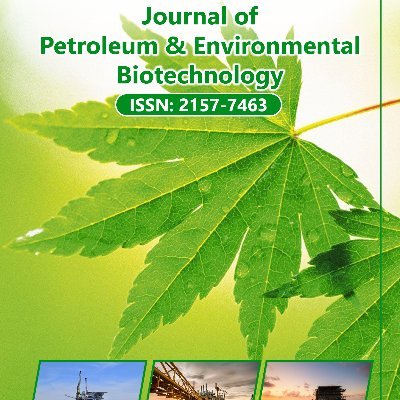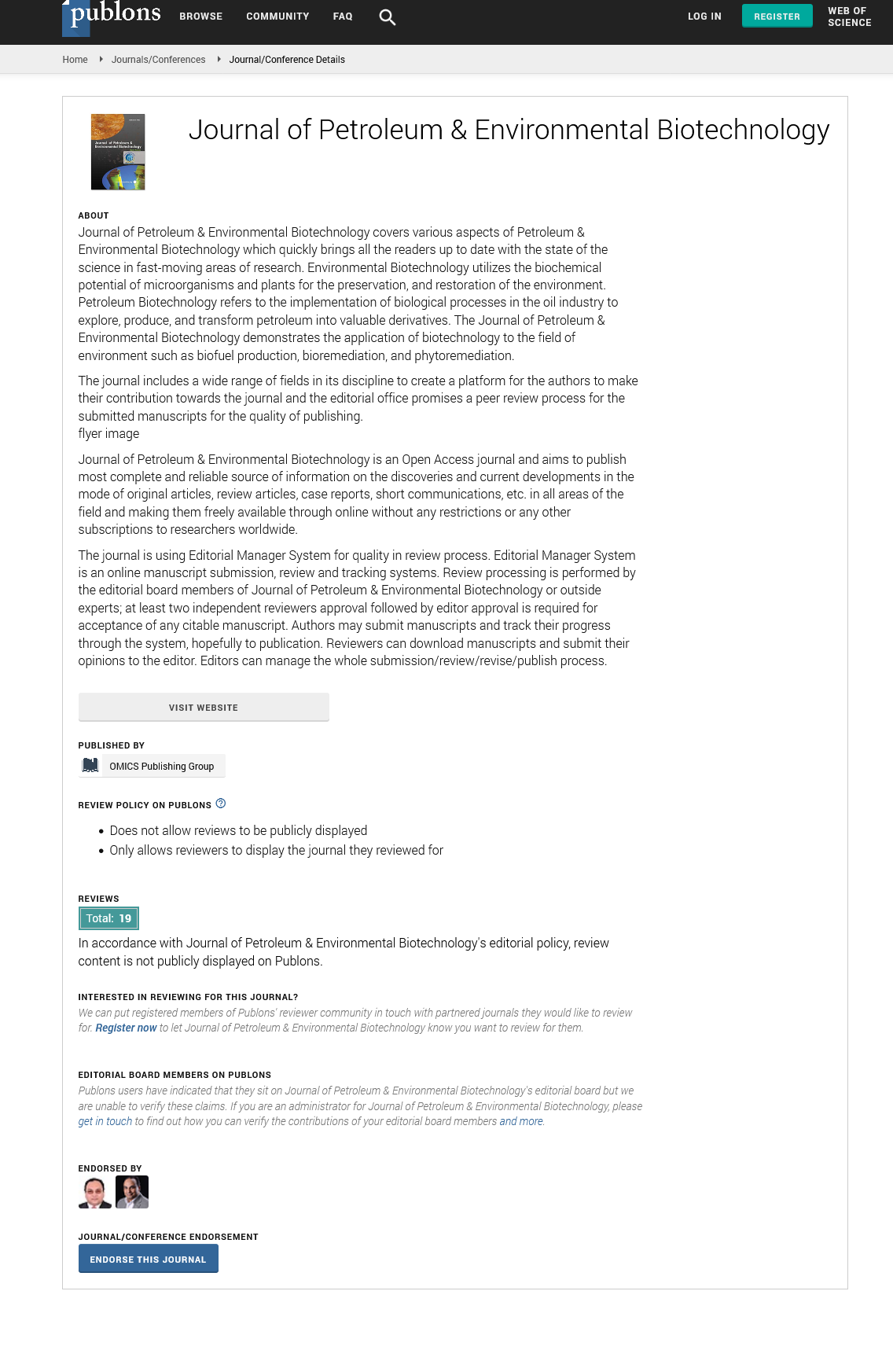Indexed In
- Open J Gate
- Genamics JournalSeek
- JournalTOCs
- China National Knowledge Infrastructure (CNKI)
- Electronic Journals Library
- RefSeek
- Hamdard University
- EBSCO A-Z
- OCLC- WorldCat
- SWB online catalog
- Virtual Library of Biology (vifabio)
- Publons
- MIAR
- Euro Pub
- Google Scholar
Useful Links
Share This Page
Journal Flyer

Open Access Journals
- Agri and Aquaculture
- Biochemistry
- Bioinformatics & Systems Biology
- Business & Management
- Chemistry
- Clinical Sciences
- Engineering
- Food & Nutrition
- General Science
- Genetics & Molecular Biology
- Immunology & Microbiology
- Medical Sciences
- Neuroscience & Psychology
- Nursing & Health Care
- Pharmaceutical Sciences
Commentary - (2024) Volume 15, Issue 3
Advancements and Challenges in Enhanced Oil Recovery Techniques for Modern Petroleum Extraction
Wang Chao*Received: 26-Aug-2024, Manuscript No. JPEB-24-27417; Editor assigned: 30-Aug-2024, Pre QC No. JPEB-24-27417 (PQ); Reviewed: 13-Sep-2024, QC No. JPEB-24-27417; Revised: 20-Sep-2024, Manuscript No. JPEB-24-27417 (R); Published: 27-Nov-2024, DOI: 10.35248/2157-7463.24.15.580
Description
The Enhanced Oil Recovery (EOR) is an advanced method used to increase the amount of crude oil that can be extracted from an oil field beyond what is possible with primary and secondary recovery methods. This article describes the latest advancements in EOR technologies and highlights the challenges faced by the industry in the modern context. The key advancements include chemical EOR, CO2 injection, microbial EOR and thermal recovery. However, several obstacles ranging from technical and economic to environmental and regulatory concerns continue to impede the widespread adoption of these techniques.
The global demand for petroleum continues to grow, putting increasing pressure on the oil industry to extract more oil from aging reservoirs. Primary and secondary recovery methods can typically only recover about 30%-50% of the total oil in a reservoir, leaving significant quantities of oil unrecovered. Enhanced Oil Recovery (EOR) techniques offer the potential to increase recovery rates to 60%-80% depending on the method employed. EOR techniques can be categorized into thermal, chemical and gas injection methods, each with its distinct advantages and challenges.
Chemical EOR involves injecting substances like surfactants, polymers and alkaline agents into the reservoir to improve the mobility of the oil. Surfactants reduce the surface tension between oil and water, while polymers increase the viscosity of the injected water, improving oil displacement. Recent advancements in chemical formulations, such as low-salinity water flooding and new surfactant blends, have enhanced the efficiency of chemical EOR, allowing for better sweep efficiency and increased oil recovery.
One of the most widely used gas injection techniques, CO2 injection involves injecting carbon dioxide into a reservoir, which dissolves in the oil and reduces its viscosity, making it easier to extract. Recent developments in CO2 EOR include the ability to capture and store CO2 from industrial processes, contributing to a dual benefit of enhanced recovery and reduced carbon emissions. Additionally, advances in monitoring and control technologies for CO2 injection have improved the precision of the process, enhancing recovery rates and reducing risks associated with CO2 leakage.
Microbial EOR (MEOR) is a relatively new method in which microorganisms are injected into the reservoir to modify the properties of the oil and rock formations. The microbes produce surfactants and gases that improve oil mobility. Recent breakthroughs in biotechnology have enabled the use of more robust and adaptable strains of bacteria, making MEOR a promising technique for unconventional and heavy oil reservoirs. Furthermore, MEOR offers the potential for a more environmentally friendly approach compared to chemical-based methods.
Steam injection techniques, such as Steam-Assisted Gravity Drainage (SAGD), involve injecting steam into the reservoir to lower the viscosity of heavy crude oil. Innovations in steam generation technologies and better reservoir monitoring have increased the efficiency of thermal recovery. The use of advanced thermal recovery techniques like cyclic steam stimulation and electromagnetic heating methods have shown promising results in extracting bitumen from oil sands and other heavy oil deposits.
The high costs associated with EOR techniques, particularly chemical and thermal methods, remain a significant challenge. The energy-intensive nature of thermal recovery methods, in particular, makes them expensive and less economical in low oil price environments. Chemical EOR techniques also require large volumes of chemicals, which adds to the operational costs. Economic feasibility is often assessed based on oil prices, but with fluctuating global markets, many EOR projects face financial uncertainty.
Reservoirs are often heterogeneous, meaning the properties of rock formations and fluids can vary significantly within the same field. This makes it difficult to predict the success of EOR techniques, especially for chemical and microbial methods, which depend on precise interactions between injected substances and the reservoir’s characteristics. Advances in reservoir modeling and simulation, however, are improving the ability to predict EOR performance, but challenges remain in accurately characterizing reservoirs.
While EOR techniques offer higher recovery rates, they also bring environmental challenges. CO2 injection, for example, while reducing greenhouse gas emissions, can result in risks associated with leakage from the reservoir or surface spills. Similarly, thermal recovery methods can lead to high water consumption and the production of large amounts of wastewater. Environmental regulations are tightening worldwide, creating pressure on oil producers to minimize their carbon footprint and manage the environmental impacts of EOR operations.
Many EOR methods, including chemical flooding and CO2 injection, require large amounts of water. The disposal of produced water, a byproduct of EOR, poses a significant challenge in regions where water is scarce. Efficient water management systems, including recycling and reuse strategies, are critical to reducing the environmental impact of EOR.
However, these systems often require substantial investment and technological advancements to function effectively. Despite the advancements in EOR technologies, there remain several technical limitations that hinder the widespread adoption of these methods. For instance, microbial EOR is still in its early stages and lacks a universally effective method for all types of reservoirs. Similarly, the efficiency of CO2 injection can be reduced by the geological characteristics of the reservoir, such as the presence of faults or low permeability zones.
The advancements in Enhanced Oil Recovery (EOR) techniques have significantly improved the recovery of oil from reservoirs that would otherwise be considered non-productive. Chemical, thermal, CO2 and microbial methods have proven their potential to increase recovery rates and extend the life of oil fields. However, challenges related to economic feasibility, reservoir heterogeneity, environmental impact and technological limitations continue to hinder the large-scale adoption of these methods. Moving forward, ongoing research, technological innovation and a greater emphasis on sustainable practices will be crucial in overcoming these challenges and ensuring the continued success of EOR in the petroleum industry.
Citation: Chao W (2024). Advancements and Challenges in Enhanced Oil Recovery Techniques for Modern Petroleum Extraction. J Pet Environ Biotechnol. 15:580.
Copyright: © 2024 Chao W. This is an open-access article distributed under the terms of the Creative Commons Attribution License, which permits unrestricted use, distribution, and reproduction in any medium, provided the original author and source are credited.

